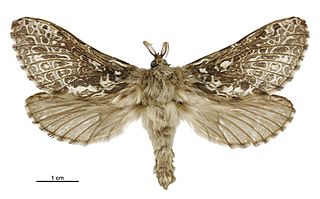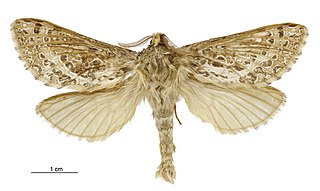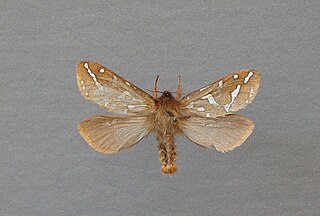
The Hepialidae are a family of insects in the lepidopteran order. Moths of this family are often referred to as swift moths or ghost moths.

Cladoxycanus is a monotypic genus of moths belonging to the family Hepialidae. It consists of only one species, Cladoxycanus minos, which is endemic to New Zealand. C. minos was first described by George Hudson in 1905.

Wiseana is a genus of moths, collectively known as porina, of the family Hepialidae. There are seven described species, all endemic to New Zealand. Some species of this genus are a major pest in New Zealand exotic pastures. It is impossible to distinguish species at the larval/caterpillar stage without DNA technology, however adult purina moth species can be visually distinguished.

Aoraia aurimaculata is a species of moth of the family Hepialidae. It was described by Alfred Philpott in 1914 from a specimen collected at The Hermitage, Mount Cook by F. S. Oliver. This holotype specimen is now lost. A. aurimaculata is endemic to New Zealand,

Aoraia enysii, also known as the forest ghost moth is a species of moth of the family Hepialidae. It is endemic to New Zealand. This is the only species of the genus Aoraia that can be found in the North as well as the South Island. This species can be found from Mount Te Aroha southwards. This species was described by Arthur Gardiner Butler in 1877 from a specimen obtained in the North Island by J. D. Enys.

Aoraia insularis, also known as the Rakiura ghost moth, is a species of moth of the family Hepialidae. It is endemic to New Zealand and is found on only on Stewart Island and Steward Island's surrounding smaller islands. It was described by John S. Dugdale in 1994.

Aoraia lenis is a species of moth of the family Hepialidae. It is endemic to New Zealand. It was described by John S. Dugdale in 1994.

Aoraia oreobolae is a species of moth in the family Hepialidae. This species is endemic to New Zealand. It is classified as "At Risk, Naturally Uncommon" by the Department of Conservation.

Aoraia rufivena, also known as the rufous-veined aoraia or the Otago ghost moth, is a species of moth of the family Hepialidae. It is endemic to New Zealand. A. rufivena was described by John S. Dugdale in 1994.

Aoraia senex is a species of moth of the family Hepialidae. It is endemic to New Zealand, where it is known from the South Island. This species was first described by George Vernon Hudson in 1908 from specimens discovered by J. H. Lewis in Central Otago.

Dioxycanus fusca is a species of moth of the family Hepialidae. It is endemic to New Zealand. This species was first described by Alfred Philpott in 1914 as Porina fusca using specimens collected by C. Fenwick and M. O. Pasco. In 1966 L. J. Dumbleton reviewed New Zealand Hepialinae and placed this species within the genus Dioxycanus, giving it the new combination Dioxycanus fuscus.

Dioxycanus oreas is a species of moth of the family Hepialidae. It is endemic to New Zealand. It was first described by George Vernon Hudson in 1920. The species was discovered by Averil Lysaght.

Dumbletonius characterifer is a species of moth of the family Hepialidae. It is endemic to New Zealand. It was first described by Francis Walker in 1865.

Dumbletonius unimaculata is a species of moth of the family Hepialidae. It is endemic to New Zealand. This species is host to the vegetable caterpillar fungus Ophiocordyceps robertsii.

Gazoryctra ganna is a moth of the family Hepialidae. It is found in Sweden, Finland, Russia (Siberia), France, Switzerland, Austria, Italy and Kazakhstan.

Wiseana cervinata, a porina moth, is a species of moth belonging to the family Hepialidae. It was described by Francis Walker in 1865 and is endemic to New Zealand.

Wiseana copularis is a species of moth belonging to the family Hepialidae. It is endemic to New Zealand. This moth is one of several very similar looking species within the genus Wiseana and this group are collectively referred to as "Porina" moths. In its larvae form this species consumes pasture grasses and, if numerous, is regarded as a pest by New Zealand farmers reliant on good quality pasture for their stock.

Wiseana fuliginea is a species of moth belonging to the family Hepialidae. It was described by Arthur Gardiner Butler in 1879 and is endemic to New Zealand.

Wiseana mimica is a species of moth belonging to the family Hepialidae. It was described by Philpott in 1923, and is endemic to New Zealand.

Wiseana signata is a species of moth belonging to the family Hepialidae. It was described by Francis Walker in 1856 and is endemic to New Zealand.





















